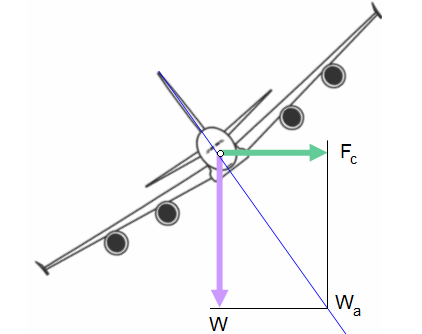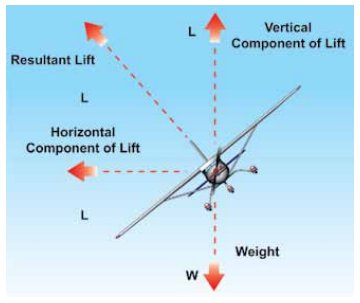This plane won't turn:

This plane will turn the wrong way - like an outside loop:

This diagram is correct:

Moderators: sky's the limit, sepia, Sulako, Right Seat Captain, lilfssister, North Shore



Well yes it's accelerating- towards the center of the turn- that's what happens in a turn. No there doesn't need to be an equilibrium of forces- only in unaccelerated flight.
What you feel is the effect of inertia, hence why centrifugal force is an apparent force in the rotating frame of reference.
You can apply the first diagram to a ball on a string. The centrifugal force is an apparent force, but we all know the ball continues in a circle because of the string. In this case, the Horizontal component of lift is the string is it not?Bede wrote: ↑Thu Oct 15, 2020 8:35 amWell yes it's accelerating- towards the center of the turn- that's what happens in a turn. No there doesn't need to be an equilibrium of forces- only in unaccelerated flight.
I think you're confusing cylindrical coordinate systems with rotating frame of reference.
True, but that's not displayed in your last pic. If those forces are correct, the plane would indefinitely slide sideways and keep accelerating. That's not what happens in a turn either. There is nothing in there that would eventually reverse it's course.
That's possible. I'll look into it a bit more.
So what's missing is the definition of the frame of reference, both in your first picture, and in your last picture.Stone on a string
If a stone is whirled round on a string, in a horizontal plane, the only real force acting on the stone in the horizontal plane is applied by the string (gravity acts vertically). There is a net force on the stone in the horizontal plane which acts toward the center.
In an inertial frame of reference, were it not for this net force acting on the stone, the stone would travel in a straight line, according to Newton's first law of motion. In order to keep the stone moving in a circular path, a centripetal force, in this case provided by the string, must be continuously applied to the stone. As soon as it is removed (for example if the string breaks) the stone moves in a straight line. In this inertial frame, the concept of centrifugal force is not required as all motion can be properly described using only real forces and Newton's laws of motion.
In a frame of reference rotating with the stone around the same axis as the stone, the stone is stationary. However, the force applied by the string is still acting on the stone. If one were to apply Newton's laws in their usual (inertial frame) form, one would conclude that the stone should accelerate in the direction of the net applied force—towards the axis of rotation—which it does not do. The centrifugal force and other fictitious forces must be included along with the real forces in order to apply Newton's laws of motion in the rotating frame.
It won't because the plane is travelling forward (make a diagram from the top). Remember acceleration is a change in velocity over time (dV/dt). Velocity has both a magnitude and direction. In the case of a turn, the magnitude is the same, but the acceleration acts to change the direction.
What the pilot feels is irrelevant. The load factor is a result of lift being greater than weight (which results in a vertical and horizontal component).
Bring on the Lorenz transforms!photofly wrote: ↑Thu Oct 15, 2020 10:27 am As Denker points out, things like Coriolis forces, centrifugal forces and even gravity itself are actually pseudo-forces that arise from having to “fix” a non inertial frame to obey the same equations as a true inertial frame. The give-away is that pseudo forces are always proportional to the mass of the object in question, because they actually represent accelerations.
We could talk about this bit..?
Hmm. Interesting. Tell me more. Reference?photofly wrote: ↑Thu Oct 15, 2020 2:38 pm Curious fact: if the aircraft is in level flight going very slowly (think slow flight) it has a high pitch attitude, then the turn is a combination of yaw, pitch, and roll - with the roll actually *away* from the direction of the turn. That's partly why you need out-of-turn aileron doing steep turns in slow flight.
